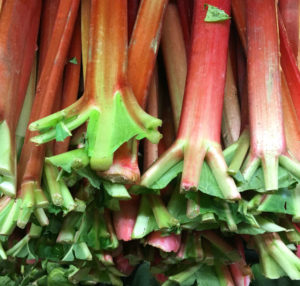With anticipation I await rhubarb’s full bouquet–deep green dinner-plate sized leaves atop fibrous stalks ranging in color from bright chartreuse green to brilliant pink–spreading close to a yard across. Its arrival is evidence that spring is here. Even before there are blossoms on my plum tree, rhubarb is ready for its first harvest.
My taste buds no longer crave the Pacific Northwest’s locally-grown winter food staples. The autumn allure of potatoes, curly kale, Tuscan Kale, cabbage, and Brussels Sprouts is gone. Locally-grown butternut squash is a distant memory. Acorn squash is still readily available from a local farmer, but it’s just not exciting. Candidly by March, the locally grown food choices have just become downright boring! I’ll admit, summer grown foods are my favorite. With rhubarb’s early spring arrival, I know summer is not far behind.

Robust Rhubarb Plant
Rhubarb is an odd vegetable. It was never prepared in my family–not by my mother or grandmothers. Rhubarb season showed up every spring on an A-frame sidewalk sign outside a local restaurant, “Come in for a fresh baked slice of strawberry rhubarb pie.” As quickly as it arrived, rhubarb was gone. Fresh asparagus quickly emerged as the “go to” spring vegetable and then the gallop-paced influx and subsequent reign of summer’s abundance commenced–strawberries, apricots, lettuces, corn, peaches, and more. I was flummoxed the first time I saw rhubarb stalks for sale at the farmers market in August. It just seemed bizarre. Isn’t rhubarb simply an early spring phenomenon? I needed to know more.
What is Rhubarb?

Ready to Use Rhubarb Stalks
Rhubarb is a vegetable! It grows from a rhizome–a bulb that sends roots and shoots out from a central node. If you buy fresh ginger root (to grate into your favorite Asian dish), it, too, is a rhizome. With rhubarb, however, only the stalk is edible. Depending on the variety and whether the vegetable is hot-house or field raised, the rhubarb stalks vary in color from a soft red blush for the entire stem or transition in color from a deep red to a chartreuse green. All stalks are topped with a deep spinach-green colored dinner-plate sized leaf. Beginning as nubs poking out of the ground in early March, by mid-April, the plant is eventually two feet tall and four feet in diameter!
The leaves, no matter how beautiful, are poisonous with oxalic acid. Oxalic acid is found in small, harmless quantities in broccoli, chives, grapefruit, and rhubarb stalks giving these foods a sharp, sometimes sour taste. It takes about 11 pounds of rhubarb leaves for a lethal dose. Even so, it’s not recommended to ingest any amount of rhubarb leaves as the digestive system would be extremely uncomfortable and gout or kidney stones could be an unwanted outcome.
Growing Rhubarb

Rhubarb Shoots and Stalks
Five years ago, I planted one rhubarb rhizome in my raised bed. Living in Seattle, where the winters are dark and it rains all the time, I needed an early season reminder that summer was on its way. It’s easy to grow. My garden reference says, “plant in an open-sunny position in deep, fertile, well-drained soil.” Pick the stalks until mid-summer. Later in the season, they become fibrous and sometimes soft, depending on how much they have been watered. Remove all the leaves and stalks in the fall. Mulch before winter with a bag of well-rotted composted garden soil or manure. After several growing seasons, when the stalks get too skinny, divide and replant using the healthy, outer, younger rhizomes. (Dividing and replanting is on my to-do list this fall.) When harvesting, pull the stalk at ground level to limit any chance of disease infestation. Use stalks, as needed, to create sauces, chutneys, infused beverages and more. It meets my criteria for gardening with ease! I get to create scrumptious unique food flavors at the dinner table, too!
In 2010, Washington led the country with 275 acres of rhubarb production. Michigan and Oregon weren’t too far behind with 200 acres apiece. According to one source, there are less than 1,000 acres of commercial production across the entire United States with some commercial production in California, too! Considering that there are about 7,000 acres of eggplant–another distinctive vegetable–rhubarb lacks the respect it deserves! With seven times more eggplant acreage, rhubarb merits a resurgence! The Pacific Northwest’s maritime climate with acidic, volcanic soils and ceaseless winter rains grow the best rhubarb! Sumner, Washington, 30 minutes southeast of Seattle is even the Rhubarb Pie Capital of the World!
My favorite rhubarb recipes are Rhubarb Chutney from Linda Ziedrich’s The Joy of Pickling, Cooking Light’s Rhubarb Liqueur, and Stewed Rhubarb from The Organic Cook’s Bible. Our baked chicken fingers get a dollop of rhubarb chutney through winter’s dark days, bringing a little bit of spring sunshine into the meal.
Every spring, I watch my rhubarb unfurl. With each passing day the deep green leaves on crimson stems push higher into the air. I know summer is on its way!
Kathryn Gardow, P.E., is a local food advocate, land use expert and owner of Gardow Consulting, LLC, an organization dedicated to providing multidisciplinary solutions to building sustainable communities. Kathryn has expertise in project management, planning, farmland conservation, and civil engineering, with an emphasis on creating communities that include food production. Kathryn’s blog muses on ways to create a more sustainable world and good food!

